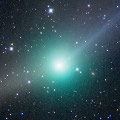
|
Now it is 8.4 mag (Apr. 27, Yoshimi Nagai). Fading slowly. In the Northern Hemisphere, it will be unobservable at 10 mag in June. In the Southern Hemisphere, it is observable in the evening low sky from April to June.
Date(TT) R.A. (2000) Decl. Delta r Elong. m1 Best Time(A, h)
May 5 8 49.60 36 7.4 2.292 2.348 80 8.9 18:39 (171, 18)
May 12 8 50.05 33 7.4 2.472 2.414 74 9.2 18:34 (165, 20)
|

|
Big asteroid discovered in 1906. It suddenly showed the cometary activity on Dec. 11, 2010, probably due to an impact of a small object. It was very bright as 11.5 mag visually (Dec. 17, 2010, Juan Jose Gonzalez). It has already turned to be stellar.
Date(TT) R.A. (2000) Decl. Delta r Elong. m1 Best Time(A, h)
May 5 16 55.65 -19 18.9 1.521 2.446 149 12.5 2:04 (180, 74)
May 12 16 50.93 -19 54.7 1.481 2.445 157 12.3 1:32 (180, 75)
|
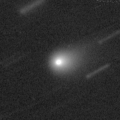
|
Already so bright as 11.6 mag and visible visually (Apr. 21, Carlos Labordena). It is expected to be bright as 9 mag from 2012 to 2013. In the Northern Hemisphere, it keeps observable in good condition for a long time until 2012 autumn when the comet brightens up to 10 mag. In the Southern Hemisphere, it is hardly observble before the perihelion passage. But it becomes observable in good condition since 2013 after the perihelion passage.
Date(TT) R.A. (2000) Decl. Delta r Elong. m1 Best Time(A, h)
May 5 14 57.82 56 38.1 3.016 3.450 107 12.8 0:07 (180, -2)
May 12 14 47.80 56 9.1 2.974 3.387 105 12.7 23:24 (180, -1)
|
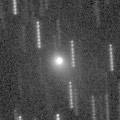
|
It brightened much faster than expected. It is so bright as 11.8 mag and visible visually (Apr. 22, Uwe Pilz). In the Northern Hemisphere, it keeps observable at 12-14 mag in good condition until early 2013. In the Southern Hemisphere, it is not observable until late 2012.
Date(TT) R.A. (2000) Decl. Delta r Elong. m1 Best Time(A, h)
May 5 21 51.84 73 34.5 2.468 2.325 70 13.5 5:13 (188,-20)
May 12 22 27.39 78 21.7 2.460 2.295 68 13.4 5:17 (186,-24)
|
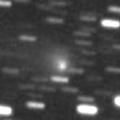
|
Now it is bright as 13.4 mag (Mar. 27, Jakub Cerny). It keeps 13-14 mag and observable in good condition until September.
Date(TT) R.A. (2000) Decl. Delta r Elong. m1 Best Time(A, h)
May 5 17 28.06 -13 6.0 4.305 5.133 141 13.5 2:37 (180, 68)
May 12 17 18.54 -12 58.4 4.234 5.135 150 13.5 2:00 (180, 68)
|

|
Now it is 14.3 mag (Mar 13, Jakub Cerny). It is already unobservable in the Northern Hemisphere. In the Southern Hemisphere, it locates extremely low now. But it will be getting higher gradually after May. It is expected to be observable at 11-13 mag for a long time from 2012 summer to 2013 summer. It will be observable in excellent condition in the Southern Hemisphere. But it is not observable until 2013 January in the Northern Hemisphere.
Date(TT) R.A. (2000) Decl. Delta r Elong. m1 Best Time(A, h)
May 5 2 9.66 -34 39.0 3.355 2.843 51 13.7 5:13 (300, 18)
May 12 2 18.39 -35 42.2 3.235 2.791 55 13.5 5:17 (298, 23)
|
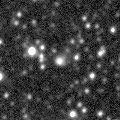
|
It is expected to be a great comet of -1 mag in 2013 spring. Now it is bright as 13.7 mag (May 2, K. Hills). Brightening faster than originally expected. In 2012, it keeps observable until summer while brightening gradually. It locates somewhat low in the Northern Hemisphere.
Date(TT) R.A. (2000) Decl. Delta r Elong. m1 Best Time(A, h)
May 5 16 37.46 -25 38.0 3.827 4.748 153 13.7 1:46 (180, 81)
May 12 16 30.47 -25 46.0 3.704 4.672 161 13.5 1:12 (180, 81)
|
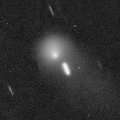
|
Now it is bright as 12.8 mag and visible visually (Mar. 14, John Drummond). It keeps bright as 13-14 mag for a long time after this until 2013. It is not observable in the Northern Hemisphere, but it is observable in good condition in the Southern Hemisphere.
Date(TT) R.A. (2000) Decl. Delta r Elong. m1 Best Time(A, h)
May 5 3 40.67 -57 19.3 5.718 5.532 74 13.6 18:39 ( 39, 30)
May 12 3 48.60 -56 20.8 5.719 5.541 74 13.6 18:34 ( 39, 28)
|

|
Now it is 12.2 mag (Mar. 25, Jakub Koukal). It is already low in the evening. It will be unobservable soon.
Date(TT) R.A. (2000) Decl. Delta r Elong. m1 Best Time(A, h)
May 5 4 54.34 18 43.4 3.024 2.208 29 13.6 18:39 (117, 5)
May 12 5 10.13 19 1.9 3.084 2.231 26 13.7 18:34 (116, 4)
|
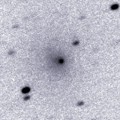
|
Another small outburst occured on May 1 and it was observed at 14.5 mag (Jean-Francois Soulier).
Date(TT) R.A. (2000) Decl. Delta r Elong. m1 Best Time(A, h)
May 5 12 8.32 -11 4.4 5.445 6.258 140 13.7 21:13 (180, 66)
May 12 12 6.77 -10 49.0 5.517 6.258 133 13.7 20:44 (180, 66)
|
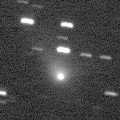
|
It brightened up to 9 mag in January and February in the evening low sky. In the Southern Hemisphere, it is observable in the evening extremely low sky in April and May. It will never be observable again in the Northern Hemisphere.
Date(TT) R.A. (2000) Decl. Delta r Elong. m1 Best Time(A, h)
May 5 4 29.00 2 42.6 2.334 1.520 28 13.9 18:39 (100, 10)
May 12 4 50.46 2 50.9 2.407 1.583 27 14.3 18:34 (100, 10)
|
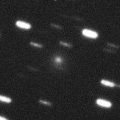
|
It was observed at 12.5 mag on Apr. 1, as bright as expected (Michael Jager). Now it is 14.0 mag (Apr. 26, Michael Jager). In the Northern Hemisphere, it locates extremely low in the morning until June. It will be observable at high location after summer. In the Southern Hemisphere, it will never be observable again.
Date(TT) R.A. (2000) Decl. Delta r Elong. m1 Best Time(A, h)
May 5 1 50.65 36 58.7 2.898 2.023 24 14.1 5:13 (237,-18)
May 12 2 9.82 38 26.5 2.965 2.093 24 14.3 5:17 (234,-16)
|
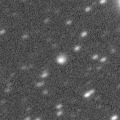
|
Now it is visible visually at 13.9 mag (Mar. 26, Jakub Cerny). It is expected to be 13 mag and will be observable in good condition in 2013. In the Northern Hemisphere, it will be getting higher gradually in the morning sky, and keeps observable for a long time. It is not observable in the Southern Hemisphere.
Date(TT) R.A. (2000) Decl. Delta r Elong. m1 Best Time(A, h)
May 5 23 28.79 50 56.8 7.038 6.477 52 14.4 5:13 (209, -7)
May 12 23 29.07 51 31.1 6.977 6.457 55 14.4 5:17 (205, -4)
|

|
This comet brightened up to 10 mag in outburst in 1995, however, it became lost after that. The condition of this apparition is bad. It is not observable around the perihelion passage. Maybe it can be recovered after summer when it appears in the morning sky.
Date(TT) R.A. (2000) Decl. Delta r Elong. m1 Best Time(A, h)
May 5 1 59.69 6 44.3 2.353 1.406 15 14.8 5:13 (264, -3)
May 12 2 22.36 8 7.1 2.365 1.426 16 14.5 5:17 (261, -2)
|
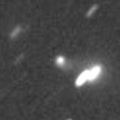
|
Now it is 14.3 mag (Mar. 27, Jakub Cerny). After this, it will be observable in good condition in the Southern Hemisphere while fading gradually. It will locate somewhat low in the Northern Hemisphere. In 2011, some visual observers reported it was very bright as 10-12 mag.
Date(TT) R.A. (2000) Decl. Delta r Elong. m1 Best Time(A, h)
May 5 22 26.47 -13 56.5 2.965 2.813 71 14.6 5:13 (245, 52)
May 12 22 35.25 -14 4.4 2.919 2.855 76 14.7 5:17 (239, 56)
|
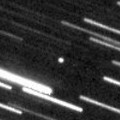
|
It will pass the perihelion on May 2. But it is not observable when it becomes bright at this apparition.
Date(TT) R.A. (2000) Decl. Delta r Elong. m1 Best Time(A, h)
May 5 2 9.84 14 38.3 0.931 0.180 9 14.6 5:13 (259, -9)
May 12 1 57.89 19 17.5 1.162 0.382 18 14.6 5:17 (249, -3)
|

|
Now it is so bright as 12.3 mag and visible visually (Mar. 22, Carlos Labordena). Although it was extremely faint as 20.5 mag at the recovery in 2010 autumn, it brightened rapidly. It will keep 12-14 mag and observable in good condition for a long time from 2012 to 2013. But it locates somewhat low in the Northern Hemisphere in 2013.
Date(TT) R.A. (2000) Decl. Delta r Elong. m1 Best Time(A, h)
May 5 12 58.31 14 20.7 2.374 3.204 138 14.7 22:03 (180, 41)
May 12 12 55.03 13 57.1 2.417 3.189 132 14.8 21:32 (180, 41)
|

|
It brightened up to 17.1 mag in late June in 2011 (June 24, J. F. Hernandez). The condition of this apparition is bad, and it was not observable around the perihelion passage. It is appearing in the morning sky in the Southern Hemisphere, but it locates extremely low. It will not be observable until June in the Northern Hemisphere, when the comet will be 15.5 mag.
Date(TT) R.A. (2000) Decl. Delta r Elong. m1 Best Time(A, h)
May 5 0 14.74 -6 14.5 2.630 2.035 44 14.8 5:13 (259, 26)
May 12 0 27.43 -4 59.3 2.614 2.072 47 14.9 5:17 (254, 29)
|
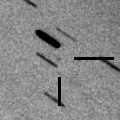
|
It will brighten up to 14 mag from May to July. It has not been observed since late January, but it must be already bright at 15 mag. In the Southern Hemisphere, it has been extremely low, but it will be getting higher gradually after this, and will be observable in good condition. It will be hardly observable in the Northern Hemisphere.
Date(TT) R.A. (2000) Decl. Delta r Elong. m1 Best Time(A, h)
May 5 2 25.98 -22 0.2 1.784 1.180 38 15.5 5:13 (291, 8)
May 12 2 39.58 -24 36.9 1.628 1.137 43 15.1 5:17 (291, 13)
|
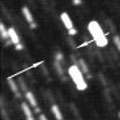
|
Now it is 16.0 mag (Mar. 26, Jakub Cerny). In the Southern Hemisphere, it will be observable at 15-16 mag in good condition for a long time until 2013 summer. It is not observable at all in the Northern Hemisphere.
Date(TT) R.A. (2000) Decl. Delta r Elong. m1 Best Time(A, h)
May 5 20 32.98 -56 47.3 3.604 3.997 105 15.3 5:13 (350, 68)
May 12 20 37.61 -59 1.3 3.517 3.984 110 15.2 5:17 ( 0, 66)
|
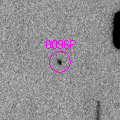
|
Now it is 18.2 mag (Apr. 20, Pierre Auger Observatory). It will brighten rapidly after this. It will approach to the sun down to 0.12 A.U. on July 14. In the Southern Hemisphere, it keeps observable in good condition except for mid July only, in the morning sky before the perihelion passage, and in the evening sky after the perihelion passage. In the Northern Hemisphere, it is not observable before the perihelion passage. But it will appear in the evening sky at 8 mag in late July. Then it keeps observable while fading rapidly in the evening low sky.
Date(TT) R.A. (2000) Decl. Delta r Elong. m1 Best Time(A, h)
May 5 23 51.04 -36 59.8 1.736 1.645 67 16.5 5:13 (290, 45)
May 12 0 17.94 -36 22.0 1.576 1.536 68 15.9 5:17 (288, 46)
|
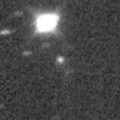
|
Now it is 16.6 mag (Apr. 27, S. Shurpakov). It will brighten up to 13.5 mag from summer to autumn. It keeps observable for a long time until December. In the Northern Hemisphere, it locates high until spring. But after that, it keeps locating low in the evening. In the Southern Henmisphere, it keeps locating low all through the time.
Date(TT) R.A. (2000) Decl. Delta r Elong. m1 Best Time(A, h)
May 5 10 47.92 36 21.3 1.999 2.427 102 16.4 19:53 (180, 19)
May 12 10 48.66 35 58.8 2.008 2.352 96 16.2 19:27 (180, 19)
|
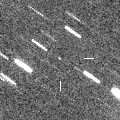
|
Now it is 16.8 mag (Apr. 15, Toshiyuki Takahashi). It brightened rapidly as expected. It keeps 16.5 mag from spring to summer. However, it locates extremely low in the Southern Hemisphere. In the Northern Hemisphere, it is getting lower gradually in the evening sky, and will be unobservable in June.
Date(TT) R.A. (2000) Decl. Delta r Elong. m1 Best Time(A, h)
May 5 6 7.83 21 59.9 2.129 1.620 47 16.6 18:39 (132, 15)
May 12 6 29.09 21 42.0 2.161 1.618 45 16.5 18:34 (131, 15)
|
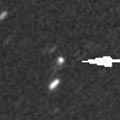
|
Now it is 16.9 mag (Apr. 14, Yasukazu Ikari). It is expected to keep 13 mag and observable in good condition in the Northern Hemisphere for a long time from 2013 to 2014. It keeps observable at 17-18 mag in good condition until June.
Date(TT) R.A. (2000) Decl. Delta r Elong. m1 Best Time(A, h)
May 5 10 27.00 11 2.8 5.813 6.226 109 16.8 19:32 (180, 44)
May 12 10 25.02 11 39.4 5.886 6.180 102 16.8 19:03 (180, 43)
|
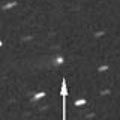
|
Now it is 16.7 mag (Apr. 14, Yasukazu Ikari). It keeps observable at 17 mag for a long time from 2011 to 2013. In 2012, it keeps observable in good condition until early September.
Date(TT) R.A. (2000) Decl. Delta r Elong. m1 Best Time(A, h)
May 5 15 36.38 6 59.3 4.699 5.622 153 16.9 0:45 (180, 48)
May 12 15 27.23 7 28.6 4.695 5.622 154 16.9 0:09 (180, 48)
|
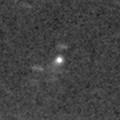
|
Now it is 16.7 mag (Apr. 21, Catalina Sky Survey). In the Northern Hemisphere, it keeps observable at 16-17 mag in good condition for a long time from 2012 to 2013. It is not observable in the Southern Hemisphere.
Date(TT) R.A. (2000) Decl. Delta r Elong. m1 Best Time(A, h)
May 5 9 18.12 65 8.6 3.988 3.910 78 16.9 18:39 (178,-10)
May 12 9 9.35 64 36.2 4.059 3.884 72 16.9 18:34 (175,-10)
|

|
It has not been observed since 2011 March. Juro Kobayashi detected a possible image of this comet at around 19 mag on Apr. 28. It is predicted to brighten up to 17 mag and will be observable in good condition from spring to summer. But actually, it seems much fainter than expected.
Date(TT) R.A. (2000) Decl. Delta r Elong. m1 Best Time(A, h)
May 5 19 27.77 -9 29.3 1.521 2.117 112 17.2 4:35 (180, 64)
May 12 19 32.19 -8 37.1 1.469 2.131 117 17.1 4:12 (180, 64)
|
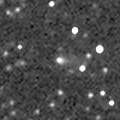
|
Now it is 17.5 mag (Apr. 19, C. Bell). It tends to brighten after the perihelion passage. It keeps observable at 17 mag from 2012 to 2013. It locates somewhat low in the Northern Hemisphere.
Date(TT) R.A. (2000) Decl. Delta r Elong. m1 Best Time(A, h)
May 5 16 41.58 -15 15.4 2.204 3.136 152 17.2 1:50 (180, 70)
May 12 16 37.91 -15 19.3 2.163 3.132 160 17.1 1:19 (180, 70)
|

|
First return of a new periodic comet which brightened up to 14 mag in 2005. It is expected to brighten up to 13 mag from summer to autumn, and will be observable in excellent condition. It locates high in the Southern Hemisphere. It is predicted to be already 18 mag. But it has not been recovered yet. Martin Masek reported it was fainter than 19.5 mag on Apr. 17.
Date(TT) R.A. (2000) Decl. Delta r Elong. m1 Best Time(A, h)
May 5 22 16.99 -24 58.7 1.963 2.013 78 17.7 5:13 (259, 60)
May 12 22 32.06 -23 36.1 1.857 1.969 80 17.5 5:17 (253, 63)
|

|
It brightened up to 13-14 mag and became visible visually from 2007 to 2009. Now it is fading. But it is still bright as 16.9 mag (Mar. 19, V. Gerke, S. Plaksa, A. Novichonok). In the Northern Hemisphere, it keeps observable in excellent condition until early summer in 2012. In the Southern Hemisphere, it locates extremely low only.
Date(TT) R.A. (2000) Decl. Delta r Elong. m1 Best Time(A, h)
May 5 9 49.84 39 29.7 11.750 11.810 90 17.5 18:55 (180, 16)
May 12 9 48.71 39 13.2 11.897 11.846 84 17.6 18:34 (179, 16)
|
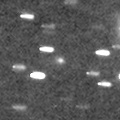
|
Brightening faster than expected. Now it is 17.5 mag (Apr. 12, Michael Jager). It will be getting lower in the evening after this. It keeps observable at 17 mag until mid June in the Northern Hemisphere, or until mid July in the Southern Hemisphere.
Date(TT) R.A. (2000) Decl. Delta r Elong. m1 Best Time(A, h)
May 5 8 23.15 20 21.8 2.625 2.618 78 17.7 18:39 (161, 32)
May 12 8 31.96 19 54.6 2.669 2.578 73 17.6 18:34 (157, 32)
|
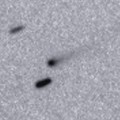
|
Now it is 16.4 mag (Apr. 15, J. F. Hernandez). It will brighten up to 13 mag in 2014. In 2012, it is observable at 17 mag in good condition in spring.
Date(TT) R.A. (2000) Decl. Delta r Elong. m1 Best Time(A, h)
May 5 10 52.85 17 3.5 3.719 4.216 112 17.6 19:58 (180, 38)
May 12 10 52.93 16 44.7 3.803 4.202 106 17.6 19:31 (180, 38)
|
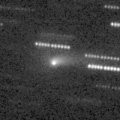
|
It reached up to 11-12 mag in 2011 autumn. Now it is fading. It has already faded down to 17.0 mag (Apr. 15, A. Diepvens). It keeps observable in good condition until May when it becomes fainter than 18 mag. It locates somewhat low in the Southern Hemisphere. A strange tail was observed in late March.
Date(TT) R.A. (2000) Decl. Delta r Elong. m1 Best Time(A, h)
May 5 11 46.78 28 7.5 1.810 2.444 117 17.8 20:52 (180, 27)
May 12 11 48.61 27 1.6 1.926 2.492 112 18.0 20:26 (180, 28)
|
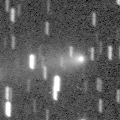
|
It had been fading after the perihelion passage in 2010 October, but it brightened again in outburst on Apr. 5, 2011. It reached up to 14.7 mag in May (May 28, Hidetaka Sato). It is bright as 17.5 mag still now, much brighter than expected (Apr. 16, Catalina Sky Survey). It locates low in the Southern Hemisphere. But in the Northern Hemisphere, it keeps observable in good condition after this. It will keep 18 mag for a while.
Date(TT) R.A. (2000) Decl. Delta r Elong. m1 Best Time(A, h)
May 5 13 2.09 21 18.5 3.413 4.179 134 18.3 22:07 (180, 34)
May 12 12 58.57 20 55.0 3.502 4.204 128 18.4 21:36 (180, 34)
|
|
![]()
 C/2011 A3 ( Gibbs )
C/2011 A3 ( Gibbs ) (3200) Phaethon
(3200) Phaethon 246P/2010 V2 ( NEAT )
246P/2010 V2 ( NEAT ) 71P/Clark
71P/Clark C/2011 U3 ( PanSTARRS )
C/2011 U3 ( PanSTARRS ) C/2011 O1 ( LINEAR )
C/2011 O1 ( LINEAR ) 96P/Machholz 1
96P/Machholz 1 C/2012 CH17 ( MOSS )
C/2012 CH17 ( MOSS ) 60P/Tsuchinshan 2
60P/Tsuchinshan 2 C/2011 J2 ( LINEAR )
C/2011 J2 ( LINEAR ) C/2010 R1 ( LINEAR )
C/2010 R1 ( LINEAR ) C/2012 A2 ( LINEAR )
C/2012 A2 ( LINEAR ) 105P/Singer Brewster
105P/Singer Brewster 152P/Helin-Lawrence
152P/Helin-Lawrence P/2005 K3 ( McNaught )
P/2005 K3 ( McNaught ) C/2005 L3 ( McNaught )
C/2005 L3 ( McNaught ) C/2012 BJ98
C/2012 BJ98 117P/Helin-Roman-Alu 1
117P/Helin-Roman-Alu 1 49P/Arend-Rigaux
49P/Arend-Rigaux 240P/2010 P1 ( NEAT )
240P/2010 P1 ( NEAT )![]()






























